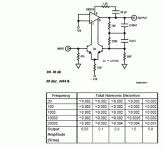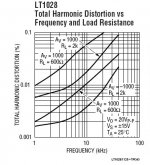Hello
Here is a phono preamp using the LM318 but at pin 1 and 5 it use a super-matched LM394 transistors pair.
The LM318 are a fast op-amp with no rise of distortions in high frequency or at very low level, its an old but good op-amp.
There is more modern op-amps but most of them do have a strong rise of distortions in high frequency or at very low level.
This circuit use an external LTP input to keep the speed but not the noise.
Any opinions, ideas ?
Bye
Gaetan
Here is a phono preamp using the LM318 but at pin 1 and 5 it use a super-matched LM394 transistors pair.
The LM318 are a fast op-amp with no rise of distortions in high frequency or at very low level, its an old but good op-amp.
There is more modern op-amps but most of them do have a strong rise of distortions in high frequency or at very low level.
This circuit use an external LTP input to keep the speed but not the noise.
Any opinions, ideas ?
Bye
Gaetan
Attachments
It's better to use a modern opamp. This technique was a sign of missing good low noise opamps. You may check for opamps with noise figures of 1 nV/Hz or so. AD797, LT1028, AD4898 etc.
It's better to use a modern opamp. This technique was a sign of missing good low noise opamps. You may check for opamps with noise figures of 1 nV/Hz or so. AD797, LT1028, AD4898 etc.
Hello peranders
Yes I know that there is op-amps with much lower noise, but looking in data sheets, most of them do have a strong rise of distortions in high frequency and at very low level, and that are not very good since it's an indication of an input common mode distortions and output crossover distortions.
Thank
Bye
Gaetan
Last edited:
What do you mean by strong rise, from what to what? Any examples?
Hello peranders
Here is an examples of strong rise of distortions in high frequency.
Bye
Gaetan
Attachments
0.04% at 20 kHz at a rather heavy load AND 60 dB is not much and if you think so you have use two opamps.
I must add that the gain is not constant in the table you have shown. The gain in only 10 at 20 kHz so the LT1028 for example will have pretty low distortion. The AD4898 has 0.0003% distortion at 100 kHz.
Last edited:
Hi,
distortion values must rise with increasing frequency, since the openloop gain is only constant to a couple of Hz (150dB@ 0-5Hz for the LT1028). With rising frequency the OL-gain sinks (<120db@100Hz, <80dB@10kHz), which means less feedback for a constant closed loop gain, hence distorton values must rise.
jauu
Calvin
distortion values must rise with increasing frequency, since the openloop gain is only constant to a couple of Hz (150dB@ 0-5Hz for the LT1028). With rising frequency the OL-gain sinks (<120db@100Hz, <80dB@10kHz), which means less feedback for a constant closed loop gain, hence distorton values must rise.
jauu
Calvin
Hello guy's
An op-amp with a high open loop gain and high slew-rate would be better but a bit more noisyer and more prone to oscillate. There is the THS4031 who are very good.
Maby I should go back to the olf faithfull OPA637.
Thank
Bye
Gaetan
An op-amp with a high open loop gain and high slew-rate would be better but a bit more noisyer and more prone to oscillate. There is the THS4031 who are very good.
Maby I should go back to the olf faithfull OPA637.
Thank
Bye
Gaetan
you can take advantage of the fact that the transfer linearity in most op´s is much better
then the common mode case. that requires to use the 0p with phase inverting shunt feedback. you can see that the LT1028 distorts much less if you go for an inverter stage (see distortion at -1000)
there is another circuit that has no common mode distortion and high input impedance if the input impedance of the shunt stage is a problem.
then the common mode case. that requires to use the 0p with phase inverting shunt feedback. you can see that the LT1028 distorts much less if you go for an inverter stage (see distortion at -1000)
there is another circuit that has no common mode distortion and high input impedance if the input impedance of the shunt stage is a problem.
Attachments
Hello
Here is a phono preamp using the LM318 but at pin 1 and 5 it use a super-matched LM394 transistors pair.
The LM318 are a fast op-amp with no rise of distortions in high frequency or at very low level, its an old but good op-amp.
There is more modern op-amps but most of them do have a strong rise of distortions in high frequency or at very low level.
This circuit use an external LTP input to keep the speed but not the noise.
Any opinions, ideas ?
Bye
Gaetan
I have found this circuit by a commercial preamp from "Musical Fidelity" without type number. The model was simply "The Preamplifier"
Don't forget that starting at 2120Kz, the RIAA response drops off at 20dB/decade, so this makes the loop gain requirement less onerous than say an amplifer that has a flat transfer function. That said, there still some pretty good new op-amps out there (as listed in above threads) that will do an alright job. LT also published a design based on their LT1115 (IIRC) - you mught want to try googling that. Otherwise, Syn08 has some fine designs. Good luck.
Here the pdf schematic from this Musical Fidelity Preamplifier:
Hello
They use a similar ideas than the LM318 phono preamp with a LM394, but they use a NE5534 who are lower noise than the LM318.
Thank for this schematic.
Bye
Gaetan
I built the circuit in question in 1980 - LM318 / LM394. It was published first in National Semiconductor's Linear Application Guide in July of 1979. I used it with my Thorens TD 126 II / Shure 3009 / Pioneer PC1000, and listened through my Tympani IIIs. There's no better phono amp circuit. Not then, not now - 40 years later. The 318's slew rate of 70v / us guarantees unmeasurable slew induced distortion or TIM and excellent feedback characteristics in the RIAA circuit when the feedback gain goes very high. The 394 supermatch pair has a noise level 1dB above ambient. Use all the more modern stuff you want, I'll match my stuff against anything, anywhere, any time. To the best of my knowledge, this is the only setup that will track the Telarc 1812 cannons accurately.
It's remarkable what can happen over the course of a thread.
TI bought National and the LM394 was dropped somewhere along the way. This company makes it anew, but it's only available through a few "boutique" distributors around the world:
Matched NPN transistor pair
TI bought National and the LM394 was dropped somewhere along the way. This company makes it anew, but it's only available through a few "boutique" distributors around the world:
Matched NPN transistor pair
Yah, it turns out there's a few op amps today that can match this performance, even better it a bit. The LMH6624 / LMH6629 come to mind, for example. If I did it again today, I expect I'd use one of those.
LM318 is not suitable for audio circuits because it has poor damping, or in other word, it rings. The super-matched LM394 transistors pair may help the noise problem to some degree in low level phono stage. But the overall performance will not be good. You can substitute the LM318 with a NE5534 and get much more audible results, but no better than an active RIAA single stage NE5534.Hello
Here is a phono preamp using the LM318 but at pin 1 and 5 it use a super-matched LM394 transistors pair.
The LM318 are a fast op-amp with no rise of distortions in high frequency or at very low level, its an old but good op-amp.
There is more modern op-amps but most of them do have a strong rise of distortions in high frequency or at very low level.
This circuit use an external LTP input to keep the speed but not the noise.
Any opinions, ideas ?
Bye
Gaetan
Most high performance design uses modern low noise opamp with 2-stage passive, active RIAA.
You're mistaken. Certainly there are modern op amps that are a better choice than the 318 / 394 pair, but the 5534 is not one of them. It's noisier than the 394, and has a significantly worse slew rate than the 318. Slew rate is critical in this application.
If you had said a 6624 or 6629 I would have accepted your post.
If you had said a 6624 or 6629 I would have accepted your post.
- Home
- Source & Line
- Analogue Source
- About a phono preamp

